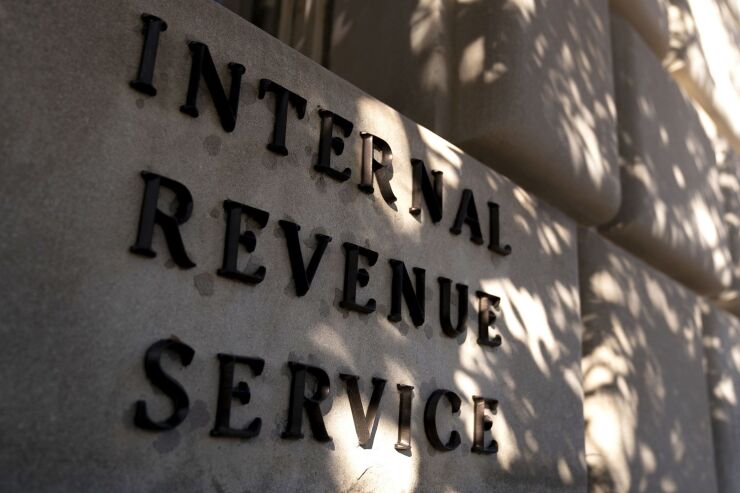IRS says special state payments and tax rebates don’t need to be reported for 2022

The Internal Revenue Service provided details late Friday on a question that has perplexed tax professionals and held up tax filings this past week, clarifying the federal tax status involving special payments made by 21 states in 2022.
The IRS said it has determined that in the interest of sound tax administration and other factors, taxpayers in many states won’t need to report these payments on their 2022 tax returns.
The IRS had caused confusion after posting a message on its website last Friday saying taxpayers in certain states should wait to file their taxes until the matter had been resolved and it promised to offer further guidance this week (see story). That caused considerable chaos just weeks after the beginning of tax season in the affected states and prompted a demand from National Taxpayer Advocate Erin Collins to offer clear guidance.

Stefani Reynolds/Photographer: Stefani Reynolds/B
During a review, the IRS said Friday it determined it won’t challenge the taxability of payments related to general welfare and disaster relief. That means people in the following states don’t need to report these state payments on their 2022 tax return: California, Colorado, Connecticut, Delaware, Florida, Hawaii, Idaho, Illinois, Indiana, Maine, New Jersey, New Mexico, New York, Oregon, Pennsylvania and Rhode Island. Alaska is in this group too, but the IRS said they look for more nuanced information below.
Many people in Georgia, Massachusetts, South Carolina and Virginia also won’t need to include state payments as part of their income for federal tax purposes if they meet certain requirements, according to the IRS. “For these individuals, state payments will not be included for federal tax purposes if the payment is a refund of state taxes paid and either the recipient claimed the standard deduction or itemized their deductions but did not receive a tax benefit,” said the IRS.
The IRS said it appreciates the patience of taxpayers, tax professionals, software companies and state tax administrators as the IRS and Treasury worked to resolve this unique and complex situation. The IRS reportedly had requested information from the Federation of Tax Administrators, a group of state tax authorities to help it clarify the rules.
The IRS also said it’s aware of questions involving special tax refunds or payments made by certain states related to the pandemic and its associated consequences in 2022. Different state programs distributed these payments last year and the rules surrounding their treatment for federal income tax purposes are complicated. While in general payments made by states are includable in income for federal tax purposes, there are exceptions that would apply to many of the payments made by states in 2022.
To help taxpayers who have received these payments file their returns in a timely fashion, the IRS is providing the additional information below.
Refund of state taxes paid
If the payment is a refund of state taxes paid and either the recipient claimed the standard deduction or itemized their deductions but did not receive a tax benefit (for example, because the $10,000 tax deduction limit applied) the payment is not included in income for federal tax purposes.
Payments from the following states in 2022 fall in this category and will be excluded from income for federal tax purposes unless the recipient received a tax benefit in the year the taxes were deducted.
- Georgia
- Massachusetts
- South Carolina
- Virginia
General welfare and disaster relief payments
If a payment is made for the promotion of the general welfare or as a disaster relief payment, for example related to the outgoing pandemic, it may be excludable from income for federal tax purposes under the General Welfare Doctrine or as a Qualified Disaster Relief Payment. Determining whether payments qualify for these exceptions is a complex fact intensive inquiry that depends on a number of considerations.
The IRS said it has reviewed the types of payments made by various states in 2022 that may fall in these categories and given the complicated fact-specific nature of determining the treatment of these payments for federal tax purposes balanced against the need to provide certainty and clarity for individuals who are now attempting to file their federal income tax returns, the IRS has determined that in the best interest of sound tax administration and given the fact that the pandemic emergency declaration is ending in May, 2023 making this an issue only for the 2022 tax year, if a taxpayer does not include the amount of one of these payments in its 2022 income for federal income tax purposes, the IRS will not challenge the treatment of the 2022 payment as excludable for income on an original or amended return.
Payments from the following states fall in this category and the IRS won’t challenge the treatment of these payments as excludable for federal income tax purposes in 2022:
- Alaska (only for the supplemental Energy Relief Payment received in addition to the annual Permanent Fund Dividend)
- California
- Colorado
- Connecticut
- Delaware
- Florida
- Hawaii
- Idaho
- Illinois (Illinois and New York issued multiple payments and in each case one of the payments was a refund of taxes, which should be treated as noted above, and one of the payments is in the category of disaster relief payment)
- Indiana
- Maine
- New Jersey
- New Mexico
- New York (see note above about Illinois and New York)
- Oregon
- Pennsylvania
- Rhode Island
For a list of the specific payments to which this applies, see this chart.
Other payments
Other payments that may have been made by states are generally includable in income for federal income tax purposes. That includes the annual payment of Alaska’s Permanent Fund Dividend and any payments from states provided as compensation to workers.


